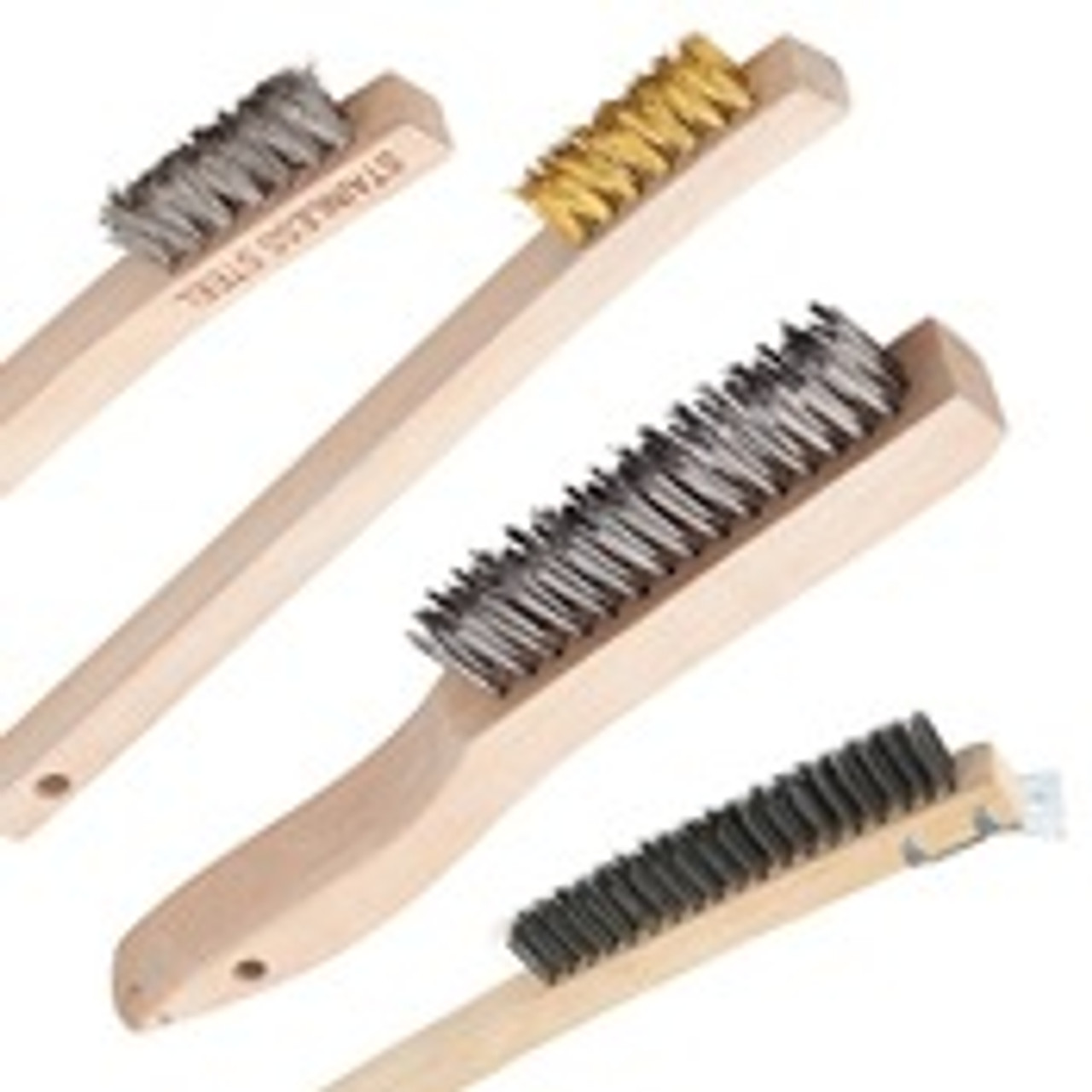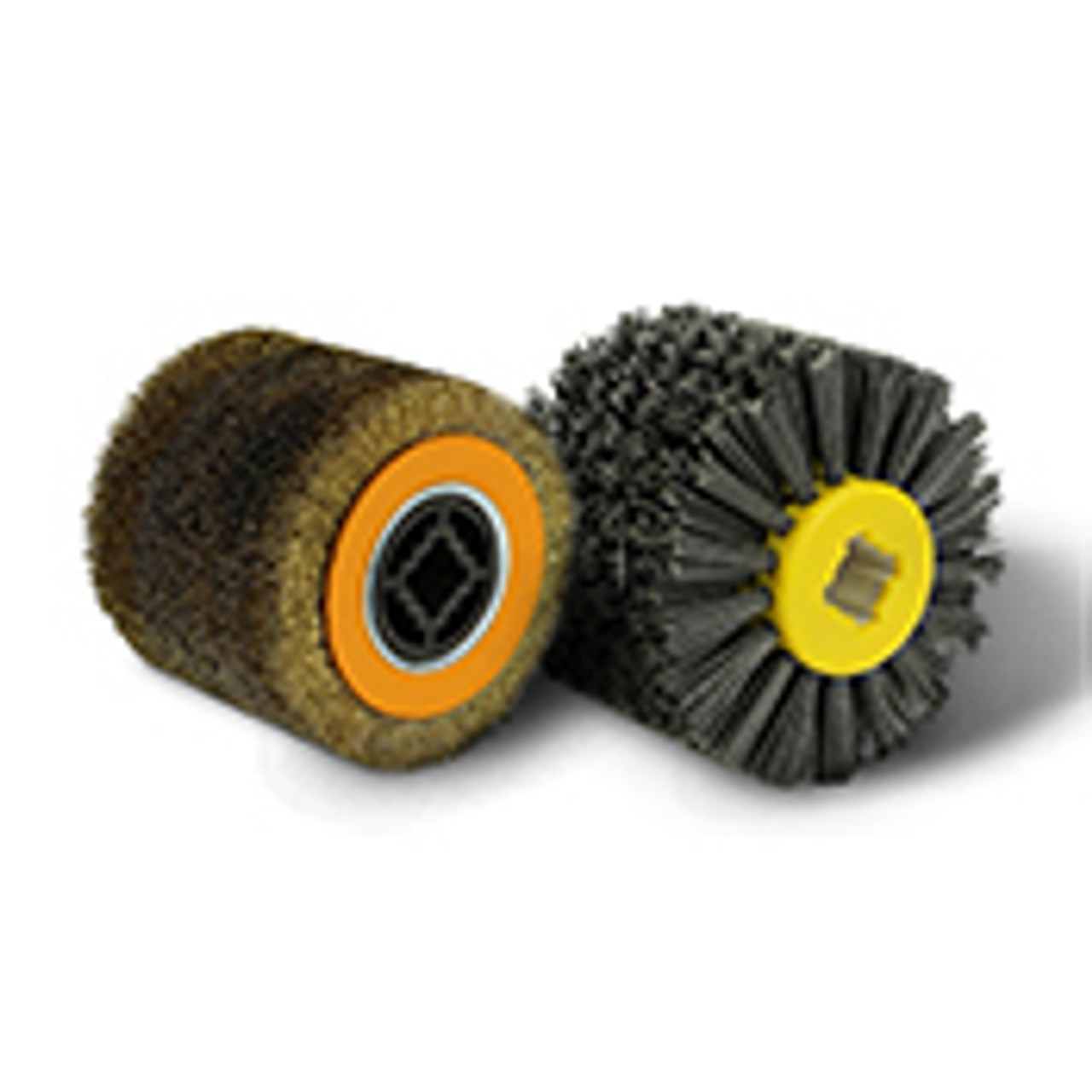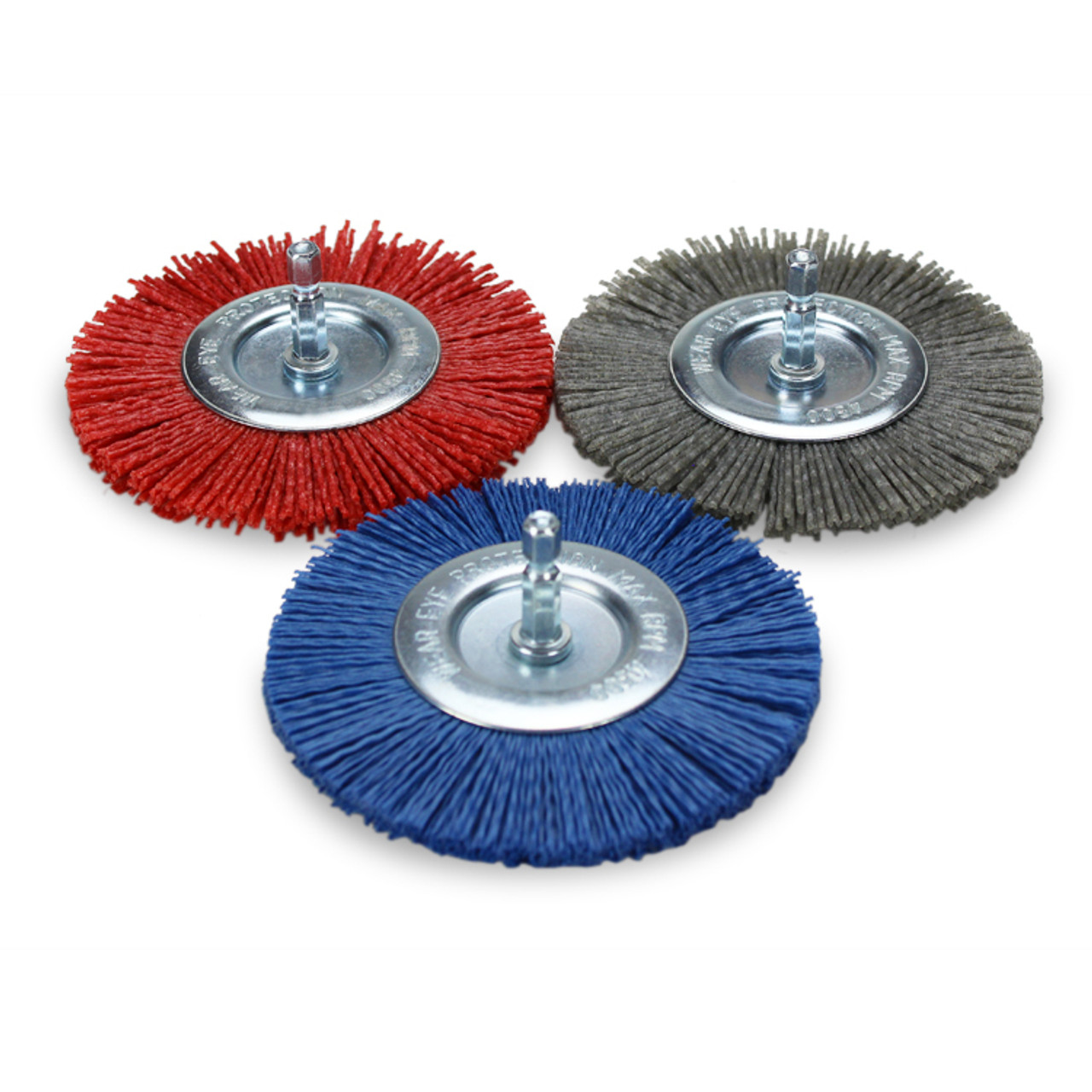Empire Abrasives Wire Wheels and Wire Brushes
We offer a full range of abrasive wire products such as wire wheels, end/cup brushes, hand-held wire brushes, wire strip flap brushes, and abrasive drums. In addition to our selection of crimped or knotted stainless steel, brass, and carbon steel options, we now offer nylon wire brushes, ideal for applications requiring precision and minimal abrasion.
Abrasive wire tools vary in design and tool compatibility, but they all are made up of stiff metal wires/filaments that can be used to grind down different types of surfaces. Below are the different types of wire abrasives we carry at EmpireAbrasives.com.
PRO TIP - When using wire abrasives, you should always use a gentle hand when in use. The sharp tips of the metal wires do the bulk of the work. Pressing too hard into the surface will bend the wires, hitting the surface at an angle rather than with the sharp tips.
Abrasive Wire Wheels
Designed with a central hub where the wires point out in a wheel-like shape. Wire wheels can be used from horizontal or vertical angles.
Compatible tools: Angle grinder, Bench grinder, Die grinder, Power drill, Walk-behind saw
Common uses: Metal surface preparation; Removal of paint, dirt, rust, weld spatter, scale, rubber flash; General cleaning; Deburring; Roughening surfaces for adhesion; Cleaning bead welds; Preparing expansive joints; Edge blending
Wire Materials: Carbon steel, Stainless steel, Brass, Nylon
Configurations: Crimped, Knotted, Stinger
Wire Cup Brushes
Similar in construction to wire wheels, except the wires point forwards instead of outwards. This allows you more flexibility with reaching surfaces from different angles than a wire wheel.
Compatible tools: Angle grinder, Die grinder, Power drill
Common uses: Metal surface preparation; Removal of paint, dirt, rust, weld spatter, scale, rubber flash; General cleaning; Deburring; Roughening surfaces for adhesion; Cleaning bead welds; Preparing expansive joints; Edge blending
Wire Materials: Carbon steel, Stainless steel, Brass, Nylon
Configurations: Crimped, Knotted
Wire End Brushes
These are another type of wire brush for drill and die grinders. With a tighter concentration of wires, these make precision work much easier than wire wheels or cup brushes. They are commonly used for working in smaller spaces and on machine parts.
Compatible tools: Die grinder, Power drill
Common uses: Carbon cleaning, removal of paint, rust, corrosion, weld slag; Deburring slots; CNC equipment maintenance; Polishing tools; Surface preparation for welding
Wire Materials: Carbon steel, Stainless steel, Tempered steel, Brass, Nylon
Configurations: Crimped, Knotted
Handheld Wire Brushes
Excellent tools for working in small spaces or when the power of a wire brush or wheel is not needed. Commonly used by welders, mechanics, and painters for it’s quick and convenient cutting action.
Compatible tools: N/A
Common uses: Removal of paint, rust stains, small burrs, scale, dirt, weld slag; Maintenance cleaning of metal surfaces; Preparing surfaces for welding
Wire Materials: Carbon steel, Stainless Steel, Brass
Configurations: N/A
Nylon Wire Brushes
Nylon wire brushes are designed with high-performance synthetic filaments that are impregnated with abrasive materials. These brushes provide a less aggressive alternative to steel wire brushes, making them perfect for precision cleaning, polishing, and working on delicate materials. Unlike traditional wire brushes, nylon options are non-sparking and won’t leave scratches or damage softer surfaces.
Common Applications:
- Cleaning rust, paint, or residue without damaging the base material
- Polishing softer metals, wood, or plastic
- Light deburring
- Finishing and surface preparation on irregular or contoured surfaces
Types of Nylon Brushes:
- Nylon Cup Brushes
- Nylon Wire Strip Flap Brushes
- Nylon Wire Wheels
- Nylon End Brushes
- Nylon Wire Brush Drums
Abrasive Wire Drums
Designed to provide the operator with more surface area coverage to quickly cut and clean a larger surface area quickly. These are often used by auto body workers to quickly remove rust from large sections of cars.
Compatible tools: Surface conditioning tool (ex. Eastwood SCT®, linear grinder, burnishing tool)
Common uses: Removal of rust, paint, glue, sealant, Bondo, body filler, scale, dross, and oxidation
Wire Materials: Steel, Nylon
Configurations: N/A
Wire Abrasives FAQ
What is the difference between crimped, knotted, twisted, and stringer beads?
Crimped Wires
The wires extending from the center are wavy/pinched in appearance. Each strand is separated from one another allowing for flexibility with the tool. This added flexibility makes the crimped best suited for uniform brushing and jobs that require less aggressive brushing. They also provide more flexibility on uneven surfaces than the alternatives.
Twisted Wires (Knotted/Braided/Stringer)
The wire strands are constructed in twisted bundles. This design adds rigidity to the wheel that allows for more aggressive brushing, extra cutting/cleaning power, and a longer life for the product.
The terms twisted, knotted, and braided are generally used interchangeably for this type of wire product. Stringer bead wire abrasives, however, are more tightly wound. This makes stringer bead designs much more rigid and more useful for aggressive brushing.
What are the different metal filaments used for?
When shopping for wire products, it is important to choose the correct wire material for the surface you are working with.
-
Carbon steel - A general purpose brush that is useful on most metals, but recommended for ferrous metals like iron, steel, or cast iron to avoid causing after-rust on non-ferrous metals
-
Stainless steel - Can be used on ferrous and non-ferrous surfaces; prevents contamination and rust
-
Tempered steel - The strongest of the available options, capable of the most aggressive cleaning and cutting
-
Brass coated steel - Not as abrasive as the other options; commonly used to clean plastic extrusion parts and/or metal surfaces without removing the base material (Not to be used on stainless steel surfaces)
-
Nylon - A versatile synthetic filament impregnated with abrasive grains that are ideal for applications requiring precision cleaning and light abrasion. Nylon brushes are non-sparking, resist heat buildup, and are safe to use on delicate materials like aluminum, wood, or plastic. They also excel at working on irregular or contoured surfaces without damaging edges or catching on bolts, brackets, or other protrusions.
How much pressure should be applied?
Only a gentle pressure is needed to get the optimal use out of these types of abrasives. Wire abrasive products all have a certain amount of give and flexibility. Forcing too much pressure will prevent the sharp ends of the wires from contacting the surface as these tools are designed for. Knotted, twisted, and stringer beads can have a bit more pressure applied than crimped as they have less give due to their specific construction.
Will my wire abrasives dull with use?
No, they are self-sharpening. As you use any of your abrasive wires, force against the ends of the strands will continuously break down the points, exposing sharp surfaces. The wires will get shorter, but the ends will remain sharp.
Why use wire abrasives over coated abrasive products?
Every task requires a different tool, but when a coated abrasive product is interchangeable with a wire product, there are some advantages:
-
Wire abrasives do not accumulate particles of the surface material that is being removed like coated abrasives
-
Wire abrasive products tend to operate at lower temperatures than coated abrasives
-
Wire products can sometimes be used to remove materials covering a metal without damaging the underlying material






